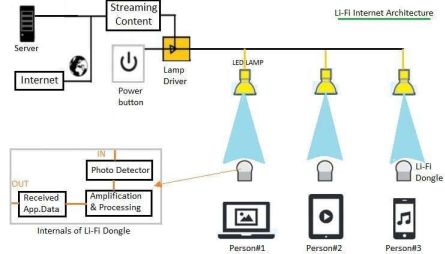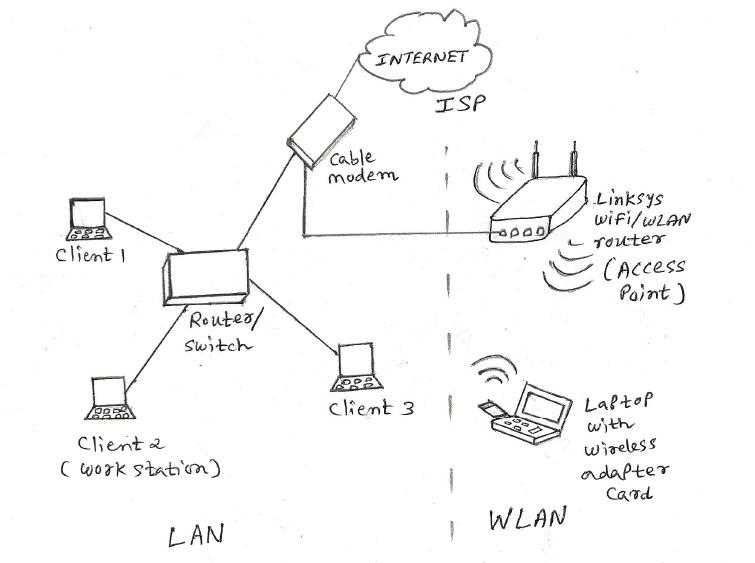By Gary Elinoff, contributing writer
The most common form of wireless technology in use today for telecommunications is Wi-Fi, which is based on radio signals operating in the range of 2.4 GHz or 5 GHZ. Wi-Fi is a well-established technology, governed internationally under IEEE 802.11 rules. And although it may be the biggest game in town, Wi-Fi isn’t alone. There are also the well-known Bluetooth and Zigbee , but there’s another rapidly advancing technology called Li-Fi, which is based on transmitting ones and zeros over light waves.
Li-Fi
First, know this: The sources of the light waves used by Li-Fi are LED lamps. As illustrated in Fig. 1 , the digitized content that is to be streamed feeds a lamp driver circuit, which imposes the content on each LED lamp. At the receiving end of the link, the receptor circuitry consists of a photo detector and circuitry to amplify the signal and convert it into a usable digital stream at each receiving device.

Fig. 1: How Li-Fi works. Image source: lifi.ae.
Wi-Fi
As for Wi-Fi, it starts with a signal received from the internet, usually by way of a cable modem. In the case depicted in Fig. 2 , internet access is granted to clients 1 to 3 via cable, the cable modem connects to a wireless router, and local devices not connected via cable but equipped for Wi-Fi gain internet access via this now-ubiquitous gateway.

Fig. 2: Typical Wi-Fi configuration . Image source: rfwireless-world.com.
It’s important to point out that the Li-Fi methodology depicted in Fig. 1 is for a one-way transmission only; no uplink is enabled. Uplink would require duplication of the configuration to enable uplink from the remote device back to the internet.
This may not necessarily be a disadvantage because Li-Fi would be very useful in situations in which information needs to be disseminated locally for specific uses, perhaps to provide lecture attendees with notes, pictures, and digitized handouts, eliminating the need for troublesome and poorly visible blackboards.
Advantages and disadvantages
Spectrum
The spectrum available for Wi-Fi is limited to an area near 5 GHz, while Li-Fi information is transmitted on beams of light, whose range is an enormous chunk of the electromagnetic spectrum, clustered around 500,000 GHz. Thus, the range of frequencies available to transmit Li-Fi data is virtually limitless. Because of this, Li-Fi has the capacity to absorb any amount of users transmitting any amount of data, while even now, there is some danger of Wi-Fi running out of room in congested areas.
Maturity
Maturity is an advantage for Wi-Fi. This stable technology is well-established, with a mature and slowly evolving set of standards that are easy for manufacturers to adhere to. In addition, a wide array of compatible, predictable hardware and software products are available for designers to rely on.
Signal penetration
Light waves and radio waves, which are the basis of Wi-Fi and Li-Fi, differ vastly on what they can pass through and what stops them. For example, solid walls stop light waves, so this can be interpreted as built-in security for Li-Fi, as restricted information will not be available to outsiders. Yet light waves will transmit through water, which will be useful for a wide range of industrial, military, and IoT purposes.
Range and transmission capacity
A single modulated LED can transmit over a range of about 10 meters, but there is no reason that a much wider range isn’t possible with multiple LEDs spaced over a wider area. Wi-Fi’s effective range is about 30 meters. Typical transmission capacities for both services are in the order of 1 Gbit per second, but both Wi-Fi and Li-Fi have the inherent capacity for much higher rates.
As of this writing, Wi-Fi is the undisputed champion of wireless data transmission. There is definite interest in Li-Fi on the part of manufacturers, but the technology hasn’t reached any kind of critical mass as of yet. But based on the several conditional advantages that Li-Fi does enjoy, and the limitations of Wi-Fi spectrum availability, it’s safe to expect considerable interest in Li-Fi over the coming years.
What do you think? Leave your thoughts in the comments section below.
Advertisement
Learn more about Electronic Products Magazine





